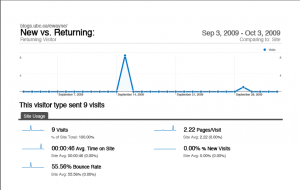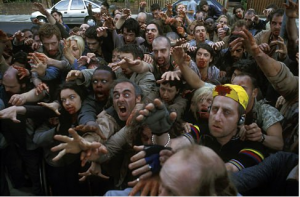
Well it’s March Madness once again. And this year I feel just a bit more connected to the big college hoops tournament than usual (even though no Canadian newspaper prints a two page spread of the brackets where I can fill in my predictions).
Of course, my beloved Tar Heels, from the University of North Carolina, are in the mix (and have a No. 1 seed in the South Regional) and have to be considered one of the favorites to win the whole shebang. Indeed, just today they were proclaimed the winner of Inside Higher Ed’s Academic Performance Tournament! Although IHE’s tournament has little to do with who actually wins the hoops competition (e.g., past APT winners include Bucknell, Holy Cross, and Davidson).
I’m particularly interested in the Midwest bracket of the NCAA tournament, where my other alma mater, the Buckeyes of THE Ohio State University are an eight seed and open play against the Siena Saints. Siena was the only local Division I hoops team when I lived in Albany, NY and thus I logged a lot of time following the Saints (both the men’s and women’s teams). Siena, btw, changed their nickname from the “Indians” back in the 1990s—more on nickname changes later.
The winner of the Ohio State v. Siena game will likely play the University of Louisville Cardinals (who will surely trounce the winner of the the “opening round” game between Alabama State and Morehead St.). I spent two and a half, let’s call them “interesting”, years on the faculty at UofHell (as it is often unaffectionately referred to) , arriving in town about the same time Planet Red landed former UK (“Go Cats”)/Boston Celtics coach Rick Pitino. Pitino outlasted me at The ‘Ville and for reasons that I will keep to myself, I’ll be cheering for either the Buckeyes or Saints in the second round match up, but admit that the Cards do have a spot in my heart (it’s just down the list, a bit at about No. 6, behind the Bearcats of Binghamton University).
The Bearcats have that special (No. 5) place in my heart because I played a very small, yet I believe significant part, in their climb from Division III mediocrity to grasping the brass ring of Division I basketball success (even if they did it by tossing academic standards in the gutter).
Back in the 1990s there was a very contentious debate on campus at Binghamton about moving its athletics program from Division III (where no athletic scholarships are offered) to the big time of Division I. The argument broke down on familiar lines. Many (probably most) faculty members at Binghamton sided against the move because it was perceived as a potential threat to academics (Binghamton was and is one of the most highly regarded campuses of the State University of New York system, the “academic jewel of SUNY” as they say). The pro-Division I argument was that ratcheting up the athletics programs would allow BU to rub shoulders with it’s academic peers in conferences like the Patriot League (incidentally the home of two past champions in IHE’s Academic Performance Tournament, Bucknell and Holy Cross).
The first move toward Division I membership by Binghamton was made in the late 1990s, when I just happened to be on the BU Athletics Board. We endorsed taking the first step to Division I by voting to move the athletics program to Division II (as required of the NCAA) and then to study the impact of that move on both the finances and academic standards of the university.
I left Binghamton for a position at the UofL in 2001, just before BU’s president and athletic director ignored a BU faculty senate vote and took Binghamton to Division I against the faculty’s will. My support for the initial move toward Division was not really popular with some of my faculty colleagues (or Dr. Mathison for that matter), but I do believe there are ways around “either/or” thinking that tends to crop up in debates over academics and athletics on campus.
So there you have my connections to this year’s tournament. But let’s not forget one indisputable bonus of BU’s move to Division I—getting that new nickname, the Beacats! Once the move to big time athletics became a real possibility, the administration wanted to tap into the profits schools derive from selling branded clothing to alumni and fans and the old nickname, the “Colonials”, just wasn’t moving t-shirts.
The Colonials mascot always reminded me of The Jolly Dumple, the famous mascot of Crazy Go Nuts University. The Jolly Dumple appears to be a dumpling with two large hands forming “thumbs-up” signs, with a drop of saliva flying out of his mouth, and wearing a tricorn hat. The costume is made of a highly combustible material called polymascotfoamalate (according to the HomeStarRunner wiki).
BU hired a marketing firm and spent big bucks in the search for a new nickname, a process that Tony Kornheiser skewered in a hilarious Washington Post column in 1999 (see below). The marketing company set out the following criteria for the new name: “gender-neutral, non-offensive, powerful, aggressive, dignified and marketable.”
I suggested a new nickname for BU that aimed at highlighting the university’s high academic standards and in particular the strong connection of its faculty to theory-building in the social sciences: “The Post-Colonials,” a choice that clearly fit the criteria.
Kornheiser’s suggestions included: The Smelt. The Binghamton Empowered Persons. The Bisexuals. The Binghamton Bada-Bing! The Bolivian Swarming River Rats. The Golden Geldings. The Binghamton Crosbys. The Fighting Beiges. The (Name of Your Corporation Here). The Binghamton Bacilli. The Fighting Hasidim. And, his favorite, The Swiss.
Go Bingo! Beat Dook!
The Fighting Hasidim
Tony Kornheiser
5 December 1999
The Washington Post
After 53 years of proudly being called the Colonials, my alma mater, Binghamton University, recently rated by Der Spiegel as one of the “better schools” in south-central New York state (motto: “We’re Only 207 Road Miles From Yale”), has decided to change the nickname of its athletic teams.
No, this wasn’t some political-correctness fix. Colonials isn’t a hideously embarrassing racial slur, like, say, Redskins–if there could possibly be somebody insensitive enough to use that as a name for a sports team. Colonials is a benign term, meaning either “a member or inhabitant of a colony” or, as I’ve just learned, those pathetic buckle shoes nobody has worn since the time of the Pilgrims, with the possible exception of Elton John.
(Jeez. All this time we were named after shoes? Whose idea was that, Judy Garland’s?)
Binghamton decided to dump “Colonials” for a much more practical reason: “Colonials” wasn’t moving T-shirts. End of discussion.
Name changes are nothing new to my school, which was originally Triple Cities College and then–when I went there–Harpur College. When people asked me where I went to school, I would say “Harpur” very fast and deliberately slur the pronunciation to see if I could fool some dopes into thinking I went to “Harvard.”
Later, it became SUNY–Binghamton. Now it’s simply Binghamton U. In a few years, it’ll probably be a Starbucks. (I took my daughter up there a few years ago, showed her the familiar red brick neo-penal architecture, and she said, “Daddy, it looks like a drug rehabilitation center.” I smiled and told her, “Sweetie, you don’t know how close you are.”)
I have to laugh when I think back to the athletic teams we had when I was in school. We were not a jock school. There was no football team. The center on our basketball team was only 6 feet 2; he had a terrific view of the opposing center’s armpits. After his junior year, he left to join the circus! Everything you need to know about the state of Harpur College athletics is embodied in the name of one of the school’s legendary stars: Jack “The Shot” Levine.
We never won anything. It wasn’t just that your guys could beat our guys; your girls could beat our guys. The piccolo section of your band could beat our guys.
Along with a new nickname, Binghamton wants a mascot, too. When I was at Harpur, we never actually had a mascot the students could relate to–I’d have suggested a cuddly stuffed animal who sat immobilized for five hours playing the first side of the “Moby Grape” album and babbling about how if you cut open a Cheez Doodle, the colors were really far out.
It’s okay with me if they want to change “Colonials” to something else, but I must express my outrage at how the new nickname was arrived at.
A marketing company was hired to prepare a list of 30 names. I quote from the alumni newsletter: “The following qualities were considered in selecting the name: gender-neutral, non-offensive, powerful, aggressive, dignified and marketable.”
(So I guess “Big Hairy Chicks on Crack” had no chance.)
What kind of nickname can you get from that commercialized, politically correct crap?
I asked my friends at work to brainstorm a name using those guidelines. Here’s what they came up with:
The Smelt.
The Binghamton Empowered Persons.
The Bisexuals.
The Binghamton Bada-Bing!
The Bolivian Swarming River Rats.
The Golden Geldings.
The Binghamton Crosbys.
The Fighting Beiges.
The (Name of Your Corporation Here).
The Binghamton Bacilli.
The Fighting Hasidim.
And my personal favorite: The Swiss.
But for some reason, Binghamton picked Bearcats.
There’s no such thing as a bearcat. It’s a mythical animal. A fraud.
My friend Tammy, who has two cats, points out quite correctly: “Of course, it is mythical. I am absolutely, positively certain my cats would never, ever, like, do it with a bear.”
(Tammy also asks, “Why aren’t there beardogs?” But that is a question for another day–and possibly another galaxy.)
The alumni journal praises the choice of Bearcat: “A cross between the power and ferocity of a bear, and the cunning and quickness of a cat.”
Well, if what you want is power and ferocity, and cunning and quickness, why not choose a nickname like “Psychotics With Chain Saws”? You think that’s not marketable? That’s got big-time “WWF Smackdown!” potential!
The University of Cincinnati has been the Bearcats for 100 years. And Cincinnati is a good athletic school. Its basketball team is No. 1 in the country now. Everyone will assume that Binghamton stole the nickname from Cincinnati. And, let’s face it, stealing from Cincinnati is about as desperate as it gets. I mean, what a dump. If Binghamton is the way your foot smells, Cincinnati is the way your foot tastes.
If you’re going to steal somebody’s nickname, steal something with power and majesty. Call yourselves: the New York Yankees.
(The Smelt is looking better, isn’t it?)
Not only isn’t “Bearcats” original, but the logo they picked is almost exactly the same as that of the NHL’s Florida Panthers. So we’ve got a phony-baloney animal and a rip-off logo. It’s all schmutz. As an alumnus in good standing (well, okay, an alumnus still standing), I am herewith ripping up the $50,000 check I had just written to the Binghamton Alumni Association.
And they can forget about a major donation until they come up with a nickname that stands for something. Something that says it all. How about the Binghamton Balding Kornhuskers!
http://www.washingtonpost.com
Copyright 1999, The Washington Post Co. All Rights Reserved
 Follow
Follow



